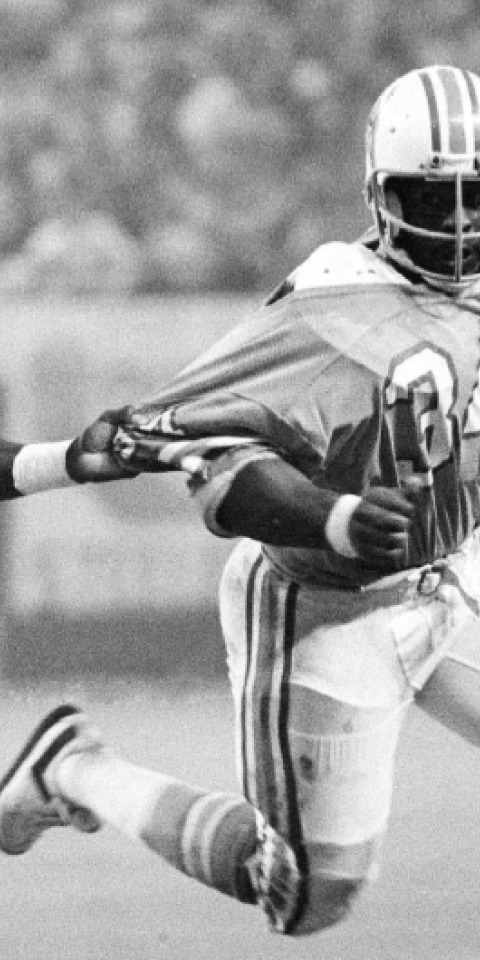When Earl Campbell arrived on the campus of the University of Texas in 1974, he had been named the best high school football in the United States. And he was surely one of the poorest.
He had $40 in his pocket, a suit that his high school sweetheart had sewn for him, and one pair of jeans that somehow fit a man with 36-inch thighs and a 30-inch waist.
Campbell would go on to endorse Wrangler jeans. And smokeless tobacco. Check YouTube for Earl’s most famous commercial: “Skoal, brother."
He also arrived in Austin with a nickname: the Tyler Rose, which derived from the fact that his hometown of Tyler, Texas grows three quarters of America’s roses.
Tyler started growing roses more than a hundred years ago when blight wiped out all the peach orchards. A good thing for UT; otherwise Campbell may have gone to the University of Georgia.
Was Earl The Best Of The Campbell Crew?
Campbell would make history at Texas, in part due to coming along at the right time. Segregation was still a thing when Campbell was born, but a ruling by a Tyler judge, William Wayne Justice (good name for a judge), spearheaded integration, giving Earl opportunities his older brothers were denied.
“Two of them were better than I, but they got caught up in the race thing and never got the chance,” Campbell said in a book on the history of Black high school football in Texas by author Michael Hurd. “My two older brothers didn’t get the same opportunity I got, or they probably would’ve gone farther than I went, as far as pro ball.”
Not everyone was enthused with Judge Justice’s ruling, which ended systematic discrimination against Black students in Tyler high schools, barred schools from flying the Confederate flag, and from playing Dixie before games.
The judge got death threats and local stylists refused to do his wife’s hair.
Campbell's Reign At Texas & Heisman Season
But by the time Campbell suited up in burnt orange, everyone was on board. He rumbled for 928 yards as a freshman in 1974 and for 1,118 yards as a sophomore in 1975.
But in 1976, Campbell had leg injuries that led to the poorest season of his varsity career, and he gained only 653 yards. Because of that and the fact the legendary Longhorns coach Darrell Royal had retired, Campbell was not among the betting favorites for the 1977 Heisman trophy when the season started.
Pitt quarterback Matt Cavanaugh, Gifford Nielsen, the Brigham Young quarterback, Oklahoma State running hack Terry Miller and Guy Benjamin, the signal caller at Stanford, were all considered more likely winners than Campbell.
But he had dropped 25 pounds between his junior and senior years, and new coach Fred Akers changed the Longhorn offense from the wishbone to a veer attack, which allowed Campbell to terrorize defenses running both inside and outside.
The Tyler Rose led the nation in rushing, with 1,744 yards on 267 carries in 11 games for an average of 158.5 yards per game, finishing four varsity seasons with 4,443 yards.
In Week 13 of that season, Campbell had four touchdowns and 222 yards rushing as Texas downed Texas A&M, 57‐28. He also left behind lots of cotton, as perhaps the most famos model of the tearaway jersey, soon to be banned by college football.
Texas would fall to Notre Dame in the Cotton Bowl 38-10, despite Campbell's 116 yards on 29 carries.
Not bad for a guy who started as a kicker in the fifth grade.
1977 Heisman Ceremony -- The First On TV
By the night of the 43rd Heisman Trophy ceremony in New York, the first to be televised live, Campbell’s competition for the award consisted of Miller and Ken MacAfee, Notre Dame's tight end.
In a nationwide vote of sports reporters and broadcasters, Campbell became the 27th running back to win the Heisman.
“I deserved what happened to me because I worked so hard. You made my Christmas a lot better and my mom's, too,” he said at the podium that December evening.
Ann Campbell was in the audience during the ceremony, and remembered trying to persuade her son not to play high school football.
"I dis-encouraged Earl," she was quoted as saying in the New York Times. “But he always loved football.”'
Post College Career & Accolades
In 1981, Earl Campbell became the fourth man in history to be named an Official State Hero, which is a nice thing to put on your resume. The three men who preceded him as official heroes, Davy Crockett, Stephen F. Austin and Sam Houston, were all at the Alamo.
During eight seasons in the NFL, mostly with Houston, Campbell made the Pro Bowl five times and was named All-Pro three times, he led the league in rushing three times and was named MVP in 1979.
He was inducted into the College Football Hall of Fame in 1990 and the Pro Football Hall of Fame one year later, and in 2019 was named to the NFL’s all-time team.
His jersey number was retired by both the University of Texas and the Tennessee Titans, the former Houston Oilers.
Campbell was the first Longhorn to win the Heisman Trophy, and the field at Darrell K. Royal-Texas Memorial Stadium is named for him and Ricky Williams, who followed in Campbell’s footsteps as a Texas running back and Heisman winner.




